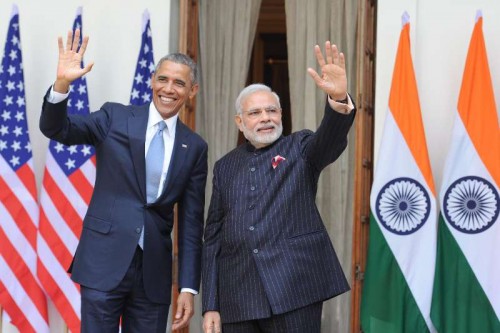
By Arun Kumar
US President Barack Obama’s historic visit to be the chief guest at India’s Republic Day celebrations turned out to be much more than symbolic as it helped cut the nuclear knot and paved the way for a ‘new era’ in India-US relations.
US Deputy National Security Advisor Ben Rhodes believes the signal that is being sent from Obama and Indian Prime Minister Narendra Modi to their respective governments “is going to catalyse a lot of activity”.
“It also sends a message to the world, I think, that the US and India are going to be closer partners going forward,” he told US reporters accompanying President Obama at a briefing in New Delhi.
“And that’s entirely consistent with the president’s focus on the Asia-Pacific region and building closer relations with emerging powers, particularly the world’s largest democracy here in India,” he said.
Recognising the importance of their deepening economic and commercial ties, India and the US also decided to expand their annual strategic dialogue into a US-India Strategic and Commercial Dialogue.
“The last two days have demonstrated that over the years India and the United States have systematically forged an indispensable partnership,” as US Commerce Secretary Penny Pritzker put it.
Pritzker, who would now jointly lead the expanded dialogue with Secretary of State John Kerry, said the developments were “indicative of a new day in the commercial relationship between India and the United States”.
The talks in New Delhi may not have led to setting up goals for reducing carbon emissions, but John Podesta, counsellor to the president, was upbeat about Modi’s “aggressive programme” to produce clean and renewable energy.
“Our ability to partner with India to help produce 100 gigawatts of solar power between now and 2022, is part of a shift across the globe towards cleaner forms of energy,” he said “and it is being done in conjunction with tackling the problem of climate change.”
Obama and Modi had “turned a corner for the United States and India”, by resolving “issues in a long-stalled nuclear deal that for years kept US nuclear power companies from doing business in India”, noted Alyssa Ayres, senior fellow for India, Pakistan, and South Asia at the Council on Foreign Relations.
Ayres, a former US deputy assistant secretary of state for South Asia, suggested that the US should now aim for bigger economic plans with India by backing India’s membership of Asia-Pacific Economic Cooperation body.
“Obama, coming out of this symbolic and important visit to India, should demonstrate that Washington will do its part for India’s future by integrating India into economic regimes focused on delivering growth,” she wrote in a commentary in Fortune.
Influential Politico magazine, noting that the US and India were getting “serious about nuclear trade”, wondered if it was a “‘New era’ for US-India relations”.
Christian Science Monitor too saw “signs of a changing US-India relationship” amid the pomp on Delhi’s Rajpath noting that “a trip to New Delhi designed to mend old differences had kicked off with a nuclear deal”.
But the influential New York Times summed it up saying “Obama’s acceptance of Modi’s invitation this year was seen” in New Delhi “as a great tribute to India, a sign of the country’s arrival on the world stage”.